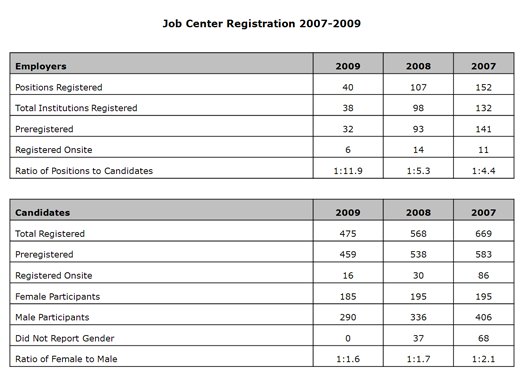| Job Center 2009 Statistics Reveal Employment Trends in the Field |
![PDF-NOTE: Internet Explorer Users, right click the PDF Icon and choose [save target as] if you are experiencing problems with clicking.](http://rsnonline.org/templates/rsntemplate-smallmasthead/images/pdf_button.png) |
 |
|
The Annual Meeting Job Center is designed to ease the communication process between candidates for academic positions and employers seeking to fill available positions. The Job Center features an Annual Meeting edition of Job Postings, candidate credentials for review, a message center, and an interview facility. The 2009 Annual Meeting Job Center saw a total of 475 candidates and 40 open positions. Though we experienced a 37 percent decrease in open positions from 2008 (largely due to the economic downturn as well as the international location of the meeting in Montréal), we maintained 84 percent of the number of candidates registered for the Center in 2008. The ratio of registered positions to registered candidates was 1:11.9. These numbers indicate, as in previous years, that the number of candidates significantly exceeds the numbers of positions available. Each year, the AAR gathers data about job positions and candidates registered for the Center. Each position and candidate is required to choose a primary classification from a provided list. They may also select additional classifications (candidates are limited to a total of three). The “primary” columns indicate the number of times each classification was chosen as a primary choice (see chart). An expanded chart is available for download here.
When drawing conclusions from this data, it is important to think of the motivations that guide employers’ and candidates’ choices. Employers tend to choose more broad classifications that correspond to the classes needing to be taught. They are likely willing to consider candidates from an array of specializations, as long as each person can teach general courses. In contrast, a candidate’s primary choice is usually his or her area of research; they can teach more broadly. Take Christian Studies as an example — one need not specialize in this area to teach a course. The fact that the classification had a 1:4 primary ratio in 2009 does not automatically mean that candidates who chose the classification each had a 25 percent chance of getting a job. Another example is Hinduism. From looking at the number of times this classification was chosen as primary in 2009, it might seem that each candidate in that field had about a 22 percent chance of getting a job. However, many candidates who chose Comparative Religions or World Religions as their specialty have the ability to teach Hinduism. So employers needing a Hinduism professor are not limited to only those candidates who consider it to be their specialty. This is where the “all” columns come into play. These columns indicate the total number of times a classification was chosen as either primary or “additional.” These columns often give better indications of the ratio of positions to candidates within a particular subfield. Take the example from above. Many of the candidates who chose Comparative Religions or World Religions likely chose Hinduism as an additional choice. Therefore, the position-to-position ratio of 1:8.5 is a better indicator of how many candidates might have sought a particular position. Still, because of the different motivations that guide choices and because many of the classifications are interrelated, the candidate to job ratios shown cannot give a clear indication of a candidate’s chances of getting a job. Rather, they serve mainly to identify trends in position openings and candidate specializations. The AAR has been compiling registration data since 1990. This data is available upon request from Jessica Davenport at This e-mail address is being protected from spambots. You need JavaScript enabled to view it . |



